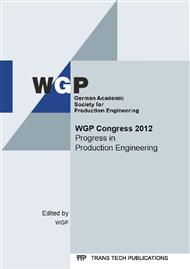[1]
Evans CJ, Bryan JB (1999) Structured", "Textured" or "Engineered, Surfaces. CIRP Annals Manuf. Technol. 48/2: 541-556.
DOI: 10.1016/s0007-8506(07)63233-8
Google Scholar
[2]
Denkena B, Kästner J, Wang B (2010) Advanced microstructures and its production through cutting and grinding. CIRP Annals Manuf. Technol. 59: 67-72.
DOI: 10.1016/j.cirp.2010.03.066
Google Scholar
[3]
Brinksmeier E, Riemer O, Twardy S (2010) Tribological behavior of micro structured surfaces for micro forming tools. Int. J. Mach. Tool Manuf. 50: 425-430.
DOI: 10.1016/j.ijmachtools.2009.11.006
Google Scholar
[4]
El-Samni OA, Chung HH, Yoon HS (2007) Drag reduction of turbulent flow over thin rectangular riblets. Int. J. of En. Sci. 45: 436-454.
DOI: 10.1016/j.ijengsci.2007.03.002
Google Scholar
[5]
Gombert A, Glaubitt W, Rose K, Dreibholz J, Zanke C, Bläsi B, Heinzel A, Horbelt W, Sporn D, Döll W, Wittwer V (1998) Glazing with very high solar transmittance. Solar Energy 62: 177-188.
DOI: 10.1016/s0038-092x(98)00008-5
Google Scholar
[6]
Scholz SG, Griffiths CA, Dimov SS, Brousseau EB, Lalev G, Petkov P (2011) Manufacturing routes for replicating micro and nano surface structures with bio-mimetic applications. CIRP J. Manuf. Sci. Technol. 4: 347-356.
DOI: 10.1016/j.cirpj.2011.05.004
Google Scholar
[7]
Barthlott W, Neinhuis C (1997) Purity of the sacred lotus, or escape from contamination in biological surfaces. Planta 202: 1-8.
DOI: 10.1007/s004250050096
Google Scholar
[8]
Lii J, Hsu WJ, Lee SP, Sia SK (2006) Microfluidics. Kirk-Othmer Encycl. Chem. Technol. 23: 959-980.
Google Scholar
[9]
Bouaidat S, Hansen O, Bruus H, Berendsen C, Bau-Madsen NK, Thomsen P, Wolff A, Jonsmanna J (2005) Surface-directed capillary system; theory, experiments and applications. Lab chip 5: 827-836.
DOI: 10.1039/b502207j
Google Scholar
[10]
Kobayashi T, Shimizu K, Kaizumac Y, Konishi S (2011) Novel combination of hydrophilic/hydrophobic surface for large wettability difference and its application to liquid manipulation. Lab chip 11: 639-644.
DOI: 10.1039/c0lc00394h
Google Scholar
[11]
Bauer WAC, Fischlechner M, Abell C, Huck WTS (2010) Hydrophilic PDMS microchannels for high-throughput formation of oil-in-water microdroplets and water-in-oil-in-water double emulsions. Lab chip 10: 1814-1819.
DOI: 10.1039/c004046k
Google Scholar
[12]
Derzsi L, Jankowski P, Lisowski W, Garstecki P (2011) Hydrophilic polycarbonate for generation of oil in water emulsions in microfluidic devices. Lab chip 11: 1151-1156.
DOI: 10.1039/c0lc00438c
Google Scholar
[13]
Öztürk E, Turan E, Caykara T (2010) Fabrication of ultrahydrophobic poly(lauryl acrylate) brushes on silicon wafer via surface-initiated atom transfer radical polymerization. Appl. Surf. Sci. 257: 1015-1020.
DOI: 10.1016/j.apsusc.2010.08.010
Google Scholar
[14]
Fiorini GS, Chiu DT (2005) Disposable microfluidic devices: fabrication, function, and application. BioTechniques 38/3: 429-446.
DOI: 10.2144/05383rv02
Google Scholar
[15]
Becker H (2009) It's the economy. Lab Chip 9: 2759-2762.
Google Scholar
[16]
Shirtcliffe NJ, McHale G, Atherton S, Newton MI (2010) An introduction to Superhydrophobicity. Adv. Colloid Interface Sci. 161: 124-138.
DOI: 10.1016/j.cis.2009.11.001
Google Scholar
[17]
Wenzel RN (1936) Resistance of solid surfaces to wetting by water. Ind. Eng. Chem. 28: 988-994.
DOI: 10.1021/ie50320a024
Google Scholar
[18]
Cassie ABD, Baxter S (1944) Wettability of porous surfaces. Trans. Faraday Soc. 40: 546-551.
DOI: 10.1039/tf9444000546
Google Scholar
[19]
Patankar NA (2004) Transition between Superhydrophobic States on Rough Surfaces. Langmuir 20: 7097-7102.
DOI: 10.1021/la049329e
Google Scholar
[20]
Johnson RE Jr, Dettre RH (1963) Contact Angle, Wettability, and Adhesion. Adv. Chem. Ser. 43: 112-135.
Google Scholar
[21]
Yoshimitsu Z, Nakajima A, Watanabe T, Hashimoto K (2002) Effects of Surface Structure on the Hydrophobicity and Sliding Behavior of Water Droplets. Langmuir 18: 5718-5822.
DOI: 10.1021/la020088p
Google Scholar
[22]
Bahadur V, Garimella SV (2009) Preventing the Cassie-Wenzel Transition Using Surfaces with Noncommunicating Roughness Elements. Langmuir 25: 4815-4820.
DOI: 10.1021/la803691m
Google Scholar
[23]
Wang J, Chen H, Sui T, Li A, Chen D (2009) Investigation on hydrophobicity of lotus leaf: Experiment and theory. Plant Sci. 176: 687-695.
DOI: 10.1016/j.plantsci.2009.02.013
Google Scholar
[24]
Balani K, Batista RG, Lahiri D, Agarwal A (2009) The hydrophobicity of a lotus leaf: a nanomechanical and computational approach. Nanotechnol. 20.
DOI: 10.1088/0957-4484/20/30/305707
Google Scholar
[25]
De Chiffre L, Kunzmann H, Peggs GN, Lucca DA (2003) Surfaces in Precision Engineering, Microengineering and Nanotechnology. CIRP Annals Manuf. Technol. 52/2: 561-577.
DOI: 10.1016/s0007-8506(07)60204-2
Google Scholar
[26]
Brinksmeier E, Autschbach L (2003) Development of Ultraprecise Milling Techniques for the Manufacture of Optical Quality Molds with Continuous and Microstructured Surfaces. Proc. euspen Int. Conf. 4.
Google Scholar
[27]
Brinksmeier E, Gläbe R, Schönemann L (2012) Review on diamond-machining processes for the generation of functional surface structures. CIRP J. Manuf. Sci. Technol. 5: 1-7.
DOI: 10.1016/j.cirpj.2011.10.003
Google Scholar
[28]
Brinksmeier E, Autschbach L (2003) Diamond Contour Boring and Raster-Milling of Molds for an Ultraprecision Open Ring Light System. Proc. euspen Int. Conf. 4: 189-192.
Google Scholar
[29]
Brinksmeier E, Gläbe R, Flucke C (2008) Manufacturing of molds for replication of micro cube corner retroreflectors. Prod. Eng. Res. Devel. 2: 33–38.
DOI: 10.1007/s11740-008-0082-8
Google Scholar
[30]
Staeves J (1998) Beurteilung der Topographie von Blechen im Hinblick auf die Reibung bei der Umformung. Dissertation, Technische Univerität Darmstadt.
Google Scholar


